Report on Pathophysiology and Pharmacology of Cardiac Disease
VerifiedAdded on 2023/01/19
|5
|1252
|88
Report
AI Summary
This report delves into the pathophysiology and pharmacology of heart failure, using a case study of a 65-year-old male patient, Trevor, diagnosed with an Inferior Acute Myocardial Infarction. It explores the underlying mechanisms of heart failure, including restrictive cardiomyopathy and its impact on ventricular function. The report details the pharmacological interventions, such as Aspirin, GTN, Clopidogrel, Heparin, and Metoprolol, prescribed to manage the condition, explaining their mechanisms of action and effects. It also discusses the evolution of heart failure treatments, including recent advances like sacubitril/valsartan and ivabradine, and highlights the importance of understanding the disease's epidemiology, mechanisms, and therapeutic advances for improved patient outcomes. The report references recent evidence-based and peer-reviewed resources to support its findings.
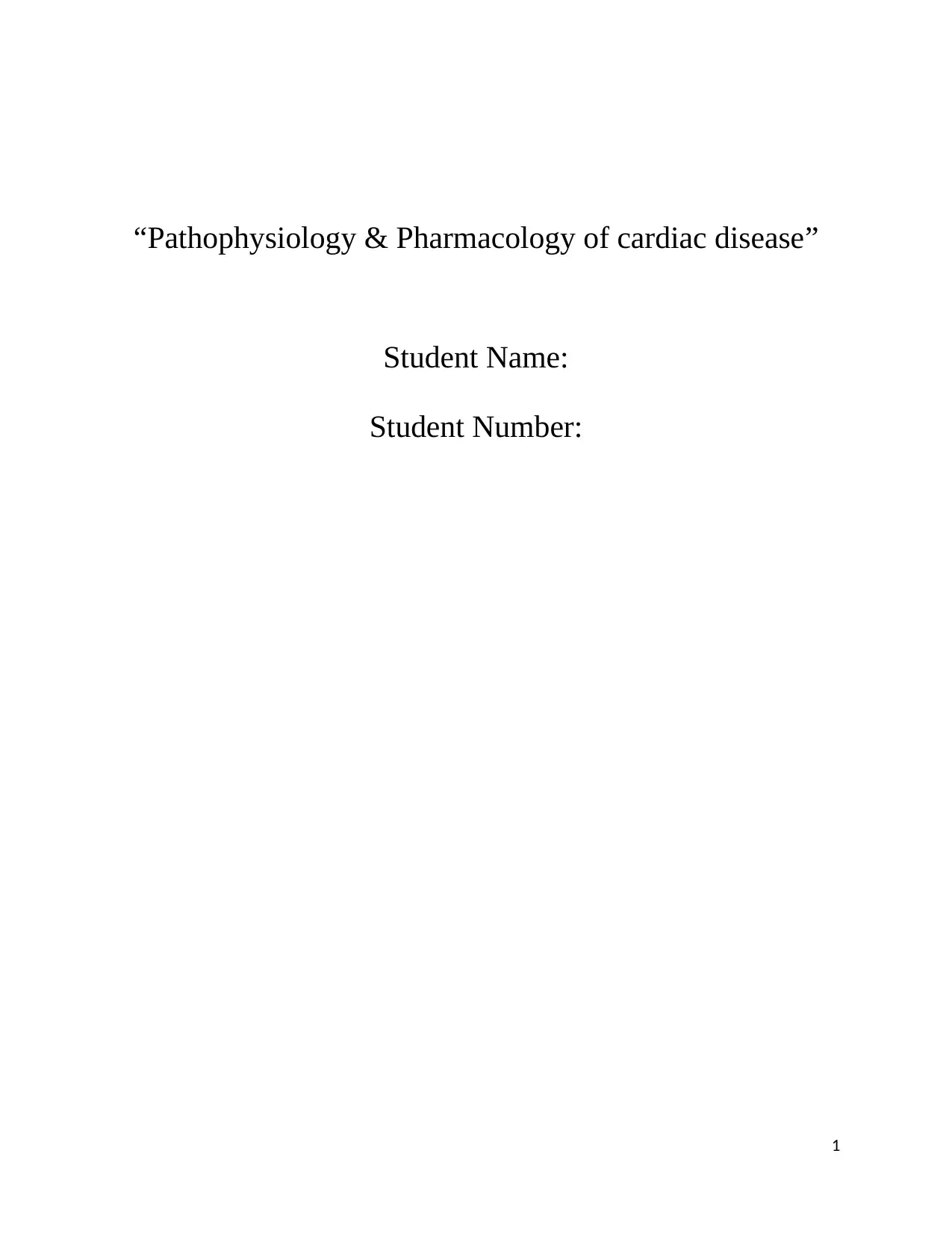
“Pathophysiology & Pharmacology of cardiac disease”
Student Name:
Student Number:
1
Student Name:
Student Number:
1
Paraphrase This Document
Need a fresh take? Get an instant paraphrase of this document with our AI Paraphraser
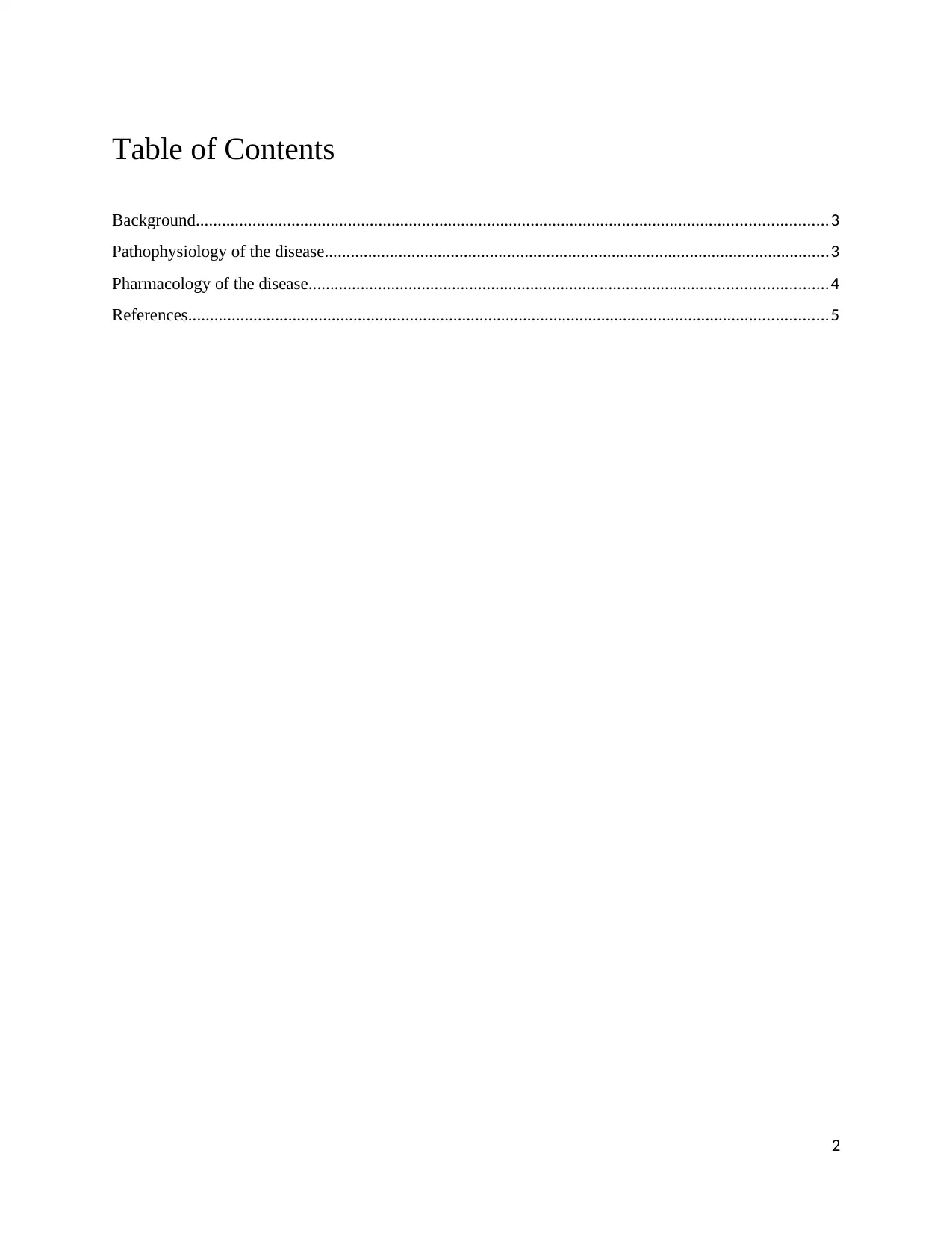
Table of Contents
Background.................................................................................................................................................3
Pathophysiology of the disease....................................................................................................................3
Pharmacology of the disease.......................................................................................................................4
References...................................................................................................................................................5
2
Background.................................................................................................................................................3
Pathophysiology of the disease....................................................................................................................3
Pharmacology of the disease.......................................................................................................................4
References...................................................................................................................................................5
2
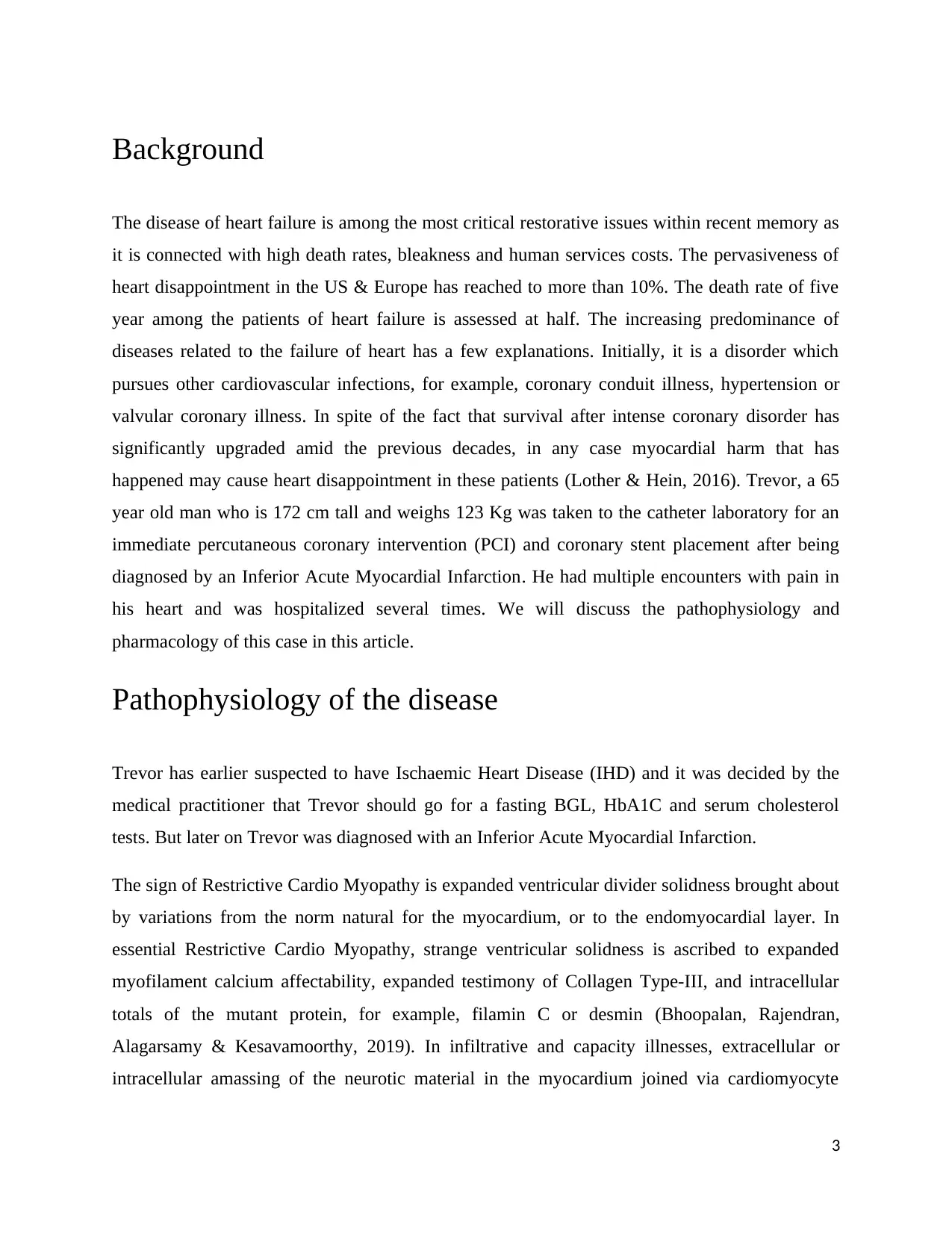
Background
The disease of heart failure is among the most critical restorative issues within recent memory as
it is connected with high death rates, bleakness and human services costs. The pervasiveness of
heart disappointment in the US & Europe has reached to more than 10%. The death rate of five
year among the patients of heart failure is assessed at half. The increasing predominance of
diseases related to the failure of heart has a few explanations. Initially, it is a disorder which
pursues other cardiovascular infections, for example, coronary conduit illness, hypertension or
valvular coronary illness. In spite of the fact that survival after intense coronary disorder has
significantly upgraded amid the previous decades, in any case myocardial harm that has
happened may cause heart disappointment in these patients (Lother & Hein, 2016). Trevor, a 65
year old man who is 172 cm tall and weighs 123 Kg was taken to the catheter laboratory for an
immediate percutaneous coronary intervention (PCI) and coronary stent placement after being
diagnosed by an Inferior Acute Myocardial Infarction. He had multiple encounters with pain in
his heart and was hospitalized several times. We will discuss the pathophysiology and
pharmacology of this case in this article.
Pathophysiology of the disease
Trevor has earlier suspected to have Ischaemic Heart Disease (IHD) and it was decided by the
medical practitioner that Trevor should go for a fasting BGL, HbA1C and serum cholesterol
tests. But later on Trevor was diagnosed with an Inferior Acute Myocardial Infarction.
The sign of Restrictive Cardio Myopathy is expanded ventricular divider solidness brought about
by variations from the norm natural for the myocardium, or to the endomyocardial layer. In
essential Restrictive Cardio Myopathy, strange ventricular solidness is ascribed to expanded
myofilament calcium affectability, expanded testimony of Collagen Type-III, and intracellular
totals of the mutant protein, for example, filamin C or desmin (Bhoopalan, Rajendran,
Alagarsamy & Kesavamoorthy, 2019). In infiltrative and capacity illnesses, extracellular or
intracellular amassing of the neurotic material in the myocardium joined via cardiomyocyte
3
The disease of heart failure is among the most critical restorative issues within recent memory as
it is connected with high death rates, bleakness and human services costs. The pervasiveness of
heart disappointment in the US & Europe has reached to more than 10%. The death rate of five
year among the patients of heart failure is assessed at half. The increasing predominance of
diseases related to the failure of heart has a few explanations. Initially, it is a disorder which
pursues other cardiovascular infections, for example, coronary conduit illness, hypertension or
valvular coronary illness. In spite of the fact that survival after intense coronary disorder has
significantly upgraded amid the previous decades, in any case myocardial harm that has
happened may cause heart disappointment in these patients (Lother & Hein, 2016). Trevor, a 65
year old man who is 172 cm tall and weighs 123 Kg was taken to the catheter laboratory for an
immediate percutaneous coronary intervention (PCI) and coronary stent placement after being
diagnosed by an Inferior Acute Myocardial Infarction. He had multiple encounters with pain in
his heart and was hospitalized several times. We will discuss the pathophysiology and
pharmacology of this case in this article.
Pathophysiology of the disease
Trevor has earlier suspected to have Ischaemic Heart Disease (IHD) and it was decided by the
medical practitioner that Trevor should go for a fasting BGL, HbA1C and serum cholesterol
tests. But later on Trevor was diagnosed with an Inferior Acute Myocardial Infarction.
The sign of Restrictive Cardio Myopathy is expanded ventricular divider solidness brought about
by variations from the norm natural for the myocardium, or to the endomyocardial layer. In
essential Restrictive Cardio Myopathy, strange ventricular solidness is ascribed to expanded
myofilament calcium affectability, expanded testimony of Collagen Type-III, and intracellular
totals of the mutant protein, for example, filamin C or desmin (Bhoopalan, Rajendran,
Alagarsamy & Kesavamoorthy, 2019). In infiltrative and capacity illnesses, extracellular or
intracellular amassing of the neurotic material in the myocardium joined via cardiomyocyte
3
⊘ This is a preview!⊘
Do you want full access?
Subscribe today to unlock all pages.

Trusted by 1+ million students worldwide
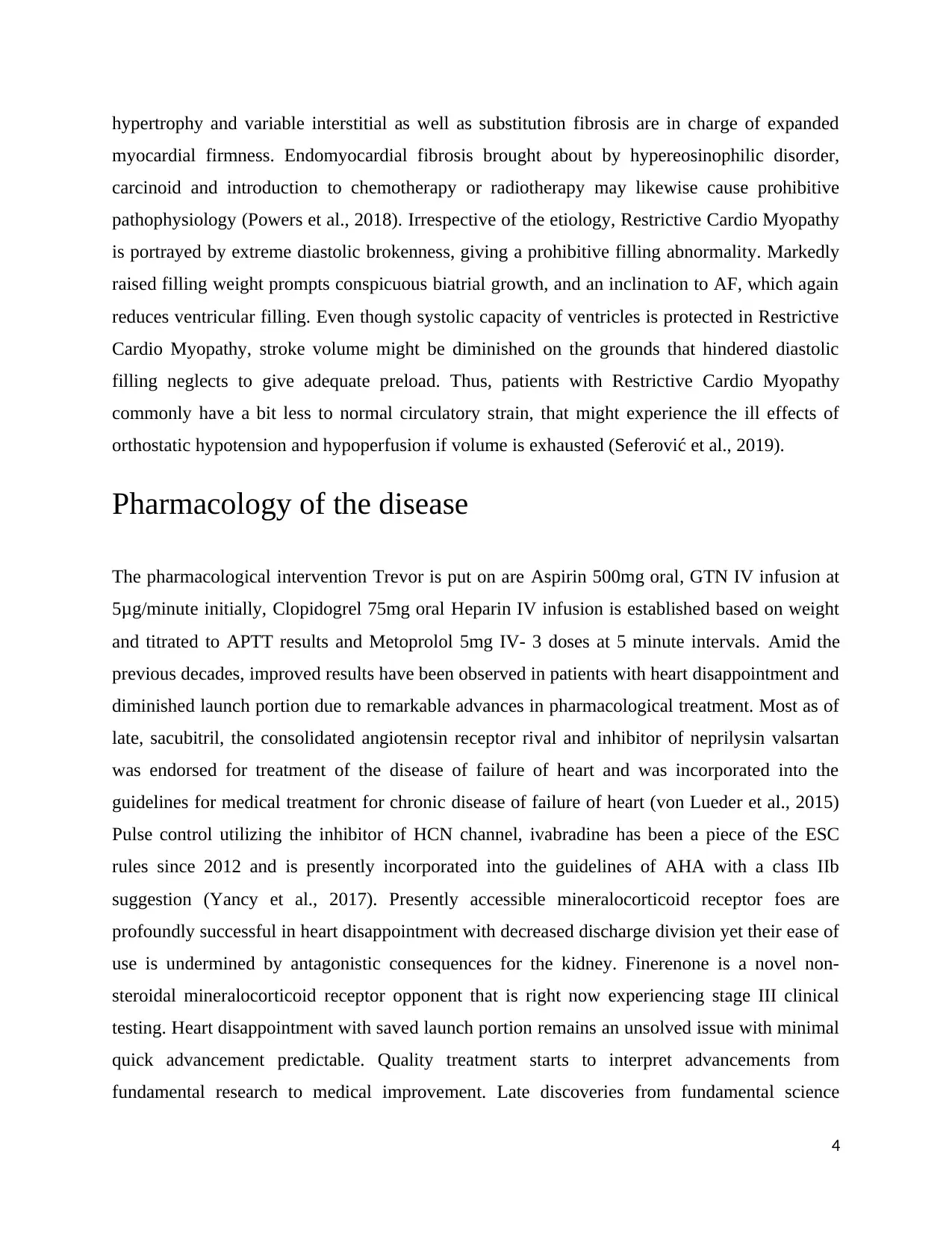
hypertrophy and variable interstitial as well as substitution fibrosis are in charge of expanded
myocardial firmness. Endomyocardial fibrosis brought about by hypereosinophilic disorder,
carcinoid and introduction to chemotherapy or radiotherapy may likewise cause prohibitive
pathophysiology (Powers et al., 2018). Irrespective of the etiology, Restrictive Cardio Myopathy
is portrayed by extreme diastolic brokenness, giving a prohibitive filling abnormality. Markedly
raised filling weight prompts conspicuous biatrial growth, and an inclination to AF, which again
reduces ventricular filling. Even though systolic capacity of ventricles is protected in Restrictive
Cardio Myopathy, stroke volume might be diminished on the grounds that hindered diastolic
filling neglects to give adequate preload. Thus, patients with Restrictive Cardio Myopathy
commonly have a bit less to normal circulatory strain, that might experience the ill effects of
orthostatic hypotension and hypoperfusion if volume is exhausted (Seferović et al., 2019).
Pharmacology of the disease
The pharmacological intervention Trevor is put on are Aspirin 500mg oral, GTN IV infusion at
5μg/minute initially, Clopidogrel 75mg oral Heparin IV infusion is established based on weight
and titrated to APTT results and Metoprolol 5mg IV- 3 doses at 5 minute intervals. Amid the
previous decades, improved results have been observed in patients with heart disappointment and
diminished launch portion due to remarkable advances in pharmacological treatment. Most as of
late, sacubitril, the consolidated angiotensin receptor rival and inhibitor of neprilysin valsartan
was endorsed for treatment of the disease of failure of heart and was incorporated into the
guidelines for medical treatment for chronic disease of failure of heart (von Lueder et al., 2015)
Pulse control utilizing the inhibitor of HCN channel, ivabradine has been a piece of the ESC
rules since 2012 and is presently incorporated into the guidelines of AHA with a class IIb
suggestion (Yancy et al., 2017). Presently accessible mineralocorticoid receptor foes are
profoundly successful in heart disappointment with decreased discharge division yet their ease of
use is undermined by antagonistic consequences for the kidney. Finerenone is a novel non-
steroidal mineralocorticoid receptor opponent that is right now experiencing stage III clinical
testing. Heart disappointment with saved launch portion remains an unsolved issue with minimal
quick advancement predictable. Quality treatment starts to interpret advancements from
fundamental research to medical improvement. Late discoveries from fundamental science
4
myocardial firmness. Endomyocardial fibrosis brought about by hypereosinophilic disorder,
carcinoid and introduction to chemotherapy or radiotherapy may likewise cause prohibitive
pathophysiology (Powers et al., 2018). Irrespective of the etiology, Restrictive Cardio Myopathy
is portrayed by extreme diastolic brokenness, giving a prohibitive filling abnormality. Markedly
raised filling weight prompts conspicuous biatrial growth, and an inclination to AF, which again
reduces ventricular filling. Even though systolic capacity of ventricles is protected in Restrictive
Cardio Myopathy, stroke volume might be diminished on the grounds that hindered diastolic
filling neglects to give adequate preload. Thus, patients with Restrictive Cardio Myopathy
commonly have a bit less to normal circulatory strain, that might experience the ill effects of
orthostatic hypotension and hypoperfusion if volume is exhausted (Seferović et al., 2019).
Pharmacology of the disease
The pharmacological intervention Trevor is put on are Aspirin 500mg oral, GTN IV infusion at
5μg/minute initially, Clopidogrel 75mg oral Heparin IV infusion is established based on weight
and titrated to APTT results and Metoprolol 5mg IV- 3 doses at 5 minute intervals. Amid the
previous decades, improved results have been observed in patients with heart disappointment and
diminished launch portion due to remarkable advances in pharmacological treatment. Most as of
late, sacubitril, the consolidated angiotensin receptor rival and inhibitor of neprilysin valsartan
was endorsed for treatment of the disease of failure of heart and was incorporated into the
guidelines for medical treatment for chronic disease of failure of heart (von Lueder et al., 2015)
Pulse control utilizing the inhibitor of HCN channel, ivabradine has been a piece of the ESC
rules since 2012 and is presently incorporated into the guidelines of AHA with a class IIb
suggestion (Yancy et al., 2017). Presently accessible mineralocorticoid receptor foes are
profoundly successful in heart disappointment with decreased discharge division yet their ease of
use is undermined by antagonistic consequences for the kidney. Finerenone is a novel non-
steroidal mineralocorticoid receptor opponent that is right now experiencing stage III clinical
testing. Heart disappointment with saved launch portion remains an unsolved issue with minimal
quick advancement predictable. Quality treatment starts to interpret advancements from
fundamental research to medical improvement. Late discoveries from fundamental science
4
Paraphrase This Document
Need a fresh take? Get an instant paraphrase of this document with our AI Paraphraser
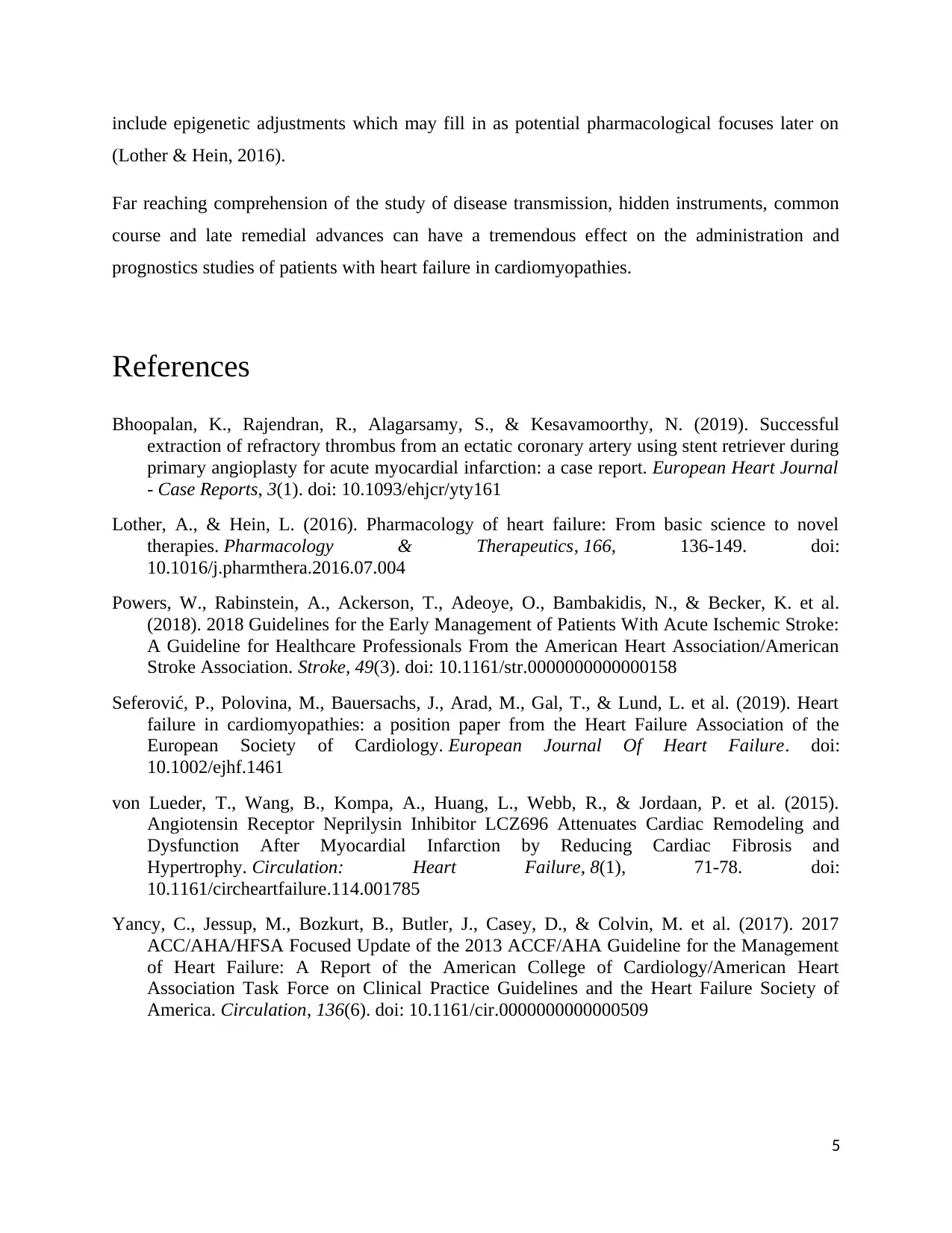
include epigenetic adjustments which may fill in as potential pharmacological focuses later on
(Lother & Hein, 2016).
Far reaching comprehension of the study of disease transmission, hidden instruments, common
course and late remedial advances can have a tremendous effect on the administration and
prognostics studies of patients with heart failure in cardiomyopathies.
References
Bhoopalan, K., Rajendran, R., Alagarsamy, S., & Kesavamoorthy, N. (2019). Successful
extraction of refractory thrombus from an ectatic coronary artery using stent retriever during
primary angioplasty for acute myocardial infarction: a case report. European Heart Journal
- Case Reports, 3(1). doi: 10.1093/ehjcr/yty161
Lother, A., & Hein, L. (2016). Pharmacology of heart failure: From basic science to novel
therapies. Pharmacology & Therapeutics, 166, 136-149. doi:
10.1016/j.pharmthera.2016.07.004
Powers, W., Rabinstein, A., Ackerson, T., Adeoye, O., Bambakidis, N., & Becker, K. et al.
(2018). 2018 Guidelines for the Early Management of Patients With Acute Ischemic Stroke:
A Guideline for Healthcare Professionals From the American Heart Association/American
Stroke Association. Stroke, 49(3). doi: 10.1161/str.0000000000000158
Seferović, P., Polovina, M., Bauersachs, J., Arad, M., Gal, T., & Lund, L. et al. (2019). Heart
failure in cardiomyopathies: a position paper from the Heart Failure Association of the
European Society of Cardiology. European Journal Of Heart Failure. doi:
10.1002/ejhf.1461
von Lueder, T., Wang, B., Kompa, A., Huang, L., Webb, R., & Jordaan, P. et al. (2015).
Angiotensin Receptor Neprilysin Inhibitor LCZ696 Attenuates Cardiac Remodeling and
Dysfunction After Myocardial Infarction by Reducing Cardiac Fibrosis and
Hypertrophy. Circulation: Heart Failure, 8(1), 71-78. doi:
10.1161/circheartfailure.114.001785
Yancy, C., Jessup, M., Bozkurt, B., Butler, J., Casey, D., & Colvin, M. et al. (2017). 2017
ACC/AHA/HFSA Focused Update of the 2013 ACCF/AHA Guideline for the Management
of Heart Failure: A Report of the American College of Cardiology/American Heart
Association Task Force on Clinical Practice Guidelines and the Heart Failure Society of
America. Circulation, 136(6). doi: 10.1161/cir.0000000000000509
5
(Lother & Hein, 2016).
Far reaching comprehension of the study of disease transmission, hidden instruments, common
course and late remedial advances can have a tremendous effect on the administration and
prognostics studies of patients with heart failure in cardiomyopathies.
References
Bhoopalan, K., Rajendran, R., Alagarsamy, S., & Kesavamoorthy, N. (2019). Successful
extraction of refractory thrombus from an ectatic coronary artery using stent retriever during
primary angioplasty for acute myocardial infarction: a case report. European Heart Journal
- Case Reports, 3(1). doi: 10.1093/ehjcr/yty161
Lother, A., & Hein, L. (2016). Pharmacology of heart failure: From basic science to novel
therapies. Pharmacology & Therapeutics, 166, 136-149. doi:
10.1016/j.pharmthera.2016.07.004
Powers, W., Rabinstein, A., Ackerson, T., Adeoye, O., Bambakidis, N., & Becker, K. et al.
(2018). 2018 Guidelines for the Early Management of Patients With Acute Ischemic Stroke:
A Guideline for Healthcare Professionals From the American Heart Association/American
Stroke Association. Stroke, 49(3). doi: 10.1161/str.0000000000000158
Seferović, P., Polovina, M., Bauersachs, J., Arad, M., Gal, T., & Lund, L. et al. (2019). Heart
failure in cardiomyopathies: a position paper from the Heart Failure Association of the
European Society of Cardiology. European Journal Of Heart Failure. doi:
10.1002/ejhf.1461
von Lueder, T., Wang, B., Kompa, A., Huang, L., Webb, R., & Jordaan, P. et al. (2015).
Angiotensin Receptor Neprilysin Inhibitor LCZ696 Attenuates Cardiac Remodeling and
Dysfunction After Myocardial Infarction by Reducing Cardiac Fibrosis and
Hypertrophy. Circulation: Heart Failure, 8(1), 71-78. doi:
10.1161/circheartfailure.114.001785
Yancy, C., Jessup, M., Bozkurt, B., Butler, J., Casey, D., & Colvin, M. et al. (2017). 2017
ACC/AHA/HFSA Focused Update of the 2013 ACCF/AHA Guideline for the Management
of Heart Failure: A Report of the American College of Cardiology/American Heart
Association Task Force on Clinical Practice Guidelines and the Heart Failure Society of
America. Circulation, 136(6). doi: 10.1161/cir.0000000000000509
5
1 out of 5
Your All-in-One AI-Powered Toolkit for Academic Success.
+13062052269
info@desklib.com
Available 24*7 on WhatsApp / Email
![[object Object]](/_next/static/media/star-bottom.7253800d.svg)
Unlock your academic potential
Copyright © 2020–2025 A2Z Services. All Rights Reserved. Developed and managed by ZUCOL.
